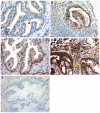A host defense mechanism involving CFTR-mediated bicarbonate secretion in bacterial prostatitis
- PMID: 21151921
- PMCID: PMC2998414
- DOI: 10.1371/journal.pone.0015255
A host defense mechanism involving CFTR-mediated bicarbonate secretion in bacterial prostatitis
Abstract
Background: Prostatitis is associated with a characteristic increase in prostatic fluid pH; however, the underlying mechanism and its physiological significance have not been elucidated.
Methodology/principal findings: In this study a primary culture of rat prostatic epithelial cells and a rat prostatitis model were used. Here we reported the involvement of CFTR, a cAMP-activated anion channel conducting both Cl(-) and HCO(3)(-), in mediating prostate HCO(3)(-) secretion and its possible role in bacterial killing. Upon Escherichia coli (E. coli)-LPS challenge, the expression of CFTR and carbonic anhydrase II (CA II), along with several pro-inflammatory cytokines was up-regulated in the primary culture of rat prostate epithelial cells. Inhibiting CFTR function in vitro or in vivo resulted in reduced bacterial killing by prostate epithelial cells or the prostate. High HCO(3)(-) content (>50 mM), rather than alkaline pH, was found to be responsible for bacterial killing. The direct action of HCO(3)(-) on bacterial killing was confirmed by its ability to increase cAMP production and suppress bacterial initiation factors in E. coli. The relevance of the CFTR-mediated HCO(3)(-) secretion in humans was demonstrated by the upregulated expression of CFTR and CAII in human prostatitis tissues.
Conclusions/significance: The CFTR and its mediated HCO(3)(-) secretion may be up-regulated in prostatitis as a host defense mechanism.
Conflict of interest statement
Figures









Similar articles
-
Novel role for pendrin in orchestrating bicarbonate secretion in cystic fibrosis transmembrane conductance regulator (CFTR)-expressing airway serous cells.J Biol Chem. 2011 Nov 25;286(47):41069-82. doi: 10.1074/jbc.M111.266734. Epub 2011 Sep 13. J Biol Chem. 2011. PMID: 21914796 Free PMC article.
-
Lymphocyte CFTR promotes epithelial bicarbonate secretion for bacterial killing.J Cell Physiol. 2012 Dec;227(12):3887-94. doi: 10.1002/jcp.24101. J Cell Physiol. 2012. PMID: 22552906
-
Intestinal bicarbonate secretion in cystic fibrosis mice.JOP. 2001 Jul;2(4 Suppl):263-7. JOP. 2001. PMID: 11875269
-
Selective activation of cystic fibrosis transmembrane conductance regulator Cl- and HCO3- conductances.JOP. 2001 Jul;2(4 Suppl):212-8. JOP. 2001. PMID: 11875262 Review.
-
CFTR and bicarbonate secretion by [correction of to] epithelial cells.News Physiol Sci. 2003 Feb;18:38-42. doi: 10.1152/nips.01412.2002. News Physiol Sci. 2003. PMID: 12531931 Review.
Cited by
-
Biotin-dependent cell envelope remodelling is required for Mycobacterium abscessus survival in lung infection.Nat Microbiol. 2023 Mar;8(3):481-497. doi: 10.1038/s41564-022-01307-5. Epub 2023 Jan 19. Nat Microbiol. 2023. PMID: 36658396 Free PMC article.
-
Multiple Regulatory Signals and Components in the Modulation of Bicarbonate Transporters.Pharmaceutics. 2024 Jan 5;16(1):78. doi: 10.3390/pharmaceutics16010078. Pharmaceutics. 2024. PMID: 38258089 Free PMC article. Review.
-
The impact of scale and frass recirculation on pathogen inactivation dynamics in black soldier fly larvae bioconversion.Front Microbiol. 2025 Mar 27;16:1539486. doi: 10.3389/fmicb.2025.1539486. eCollection 2025. Front Microbiol. 2025. PMID: 40212386 Free PMC article.
-
Cystic fibrosis transmembrane conductance regulator in the gills of the climbing perch, Anabas testudineus, is involved in both hypoosmotic regulation during seawater acclimation and active ammonia excretion during ammonia exposure.J Comp Physiol B. 2012 Aug;182(6):793-812. doi: 10.1007/s00360-012-0664-9. Epub 2012 Apr 22. J Comp Physiol B. 2012. PMID: 22526263
-
Airway Surface Liquid pH Regulation in Airway Epithelium Current Understandings and Gaps in Knowledge.Int J Mol Sci. 2021 Mar 25;22(7):3384. doi: 10.3390/ijms22073384. Int J Mol Sci. 2021. PMID: 33806154 Free PMC article. Review.
References
-
- Snow DC, Shoskes DA. Pharmacotherapy of prostatitis. Expert Opin Pharmacother 2010 - PubMed
-
- Lipsky BA, Byren I, Hoey CT. Treatment of bacterial prostatitis. Clin Infect Dis. 2010;50:1641–1652. - PubMed
-
- Giamarellou H, Tympanidis K, Bitos NA, Leonidas E, Daikos GK. Infertility and chronic prostatitis. Andrologia. 1984;16:417–422. - PubMed
-
- Wolff H, Bezold G, Zebhauser M, Meurer M. Impact of clinically silent inflammation on male genital tract organs as reflected by biochemical markers in semen. J Androl. 1991;12:331–334. - PubMed
-
- Leib Z, Bartoov B, Eltes F, Servadio C. Reduced semen quality caused by chronic abacterial prostatitis: an enigma or reality? Fertil Steril. 1994;61:1109–1116. - PubMed
Publication types
MeSH terms
Substances
LinkOut - more resources
Full Text Sources
Other Literature Sources

